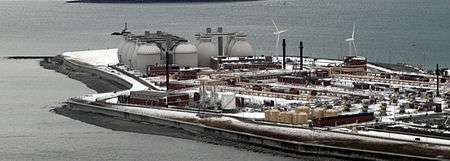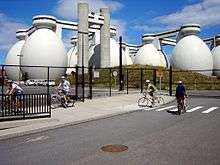Deer Island Waste Water Treatment Plant


The Deer Island Waste Water Treatment Plant (also known as Deer Island Sewage Treatment Plant) operated by The Massachusetts Water Resources Authority is located on Deer Island, one of the Boston Harbor Islands in Boston Harbor. The plant began partial operations in 1995 and was fully operational in 2000 with the completion of the outfall tunnel.[1]
Deer Island is the second largest sewage treatment plant in the United States.[2] The plant is a key part of the program to protect Boston Harbor against pollution from sewer systems in eastern Massachusetts, mandated by a 1984 federal court ruling by Judge Paul G. Garrity in a case brought under the Clean Water Act.[3][4]
From the 1880s until 1991, the northeastern side of the island was the location of the Deer Island Prison.
History
The first sanitary sewer system for the Boston area, serving eighteen cities and towns, opened in 1884. It collected raw sewerage on Moon Island in the harbor, and discharged it 500 feet off shore, with the ebbing tide.[1]
In 1889 the Metropolitan Sewerage District was formed and, over the next fifteen years, built one of the finest regional sewerage systems in the country, although it still discharged the raw sewerage into the ocean.[1]
By 1940 there were three points, on Nut, Deer, and Moon islands, for the discharge of raw sewage into the oceans.[1] This sewage had contaminated the shellfish beds to the point that discussions of building treatment plants began. The Nut Island plant opened in 1951. The Deer Island plant opened in 1968, and Moon Island was converted to standby, overflow, operation.[1]
The Metropolitan Sewerage District, was rolled into a new, larger, entity, the Massachusetts Water Resources Authority (MWRA), in 1985.[1] Under the Federal Court order,[3] the new District, completely rebuilt the treatment system, between 1985 and 2000.[1] At the end of this process all sewage is treated and the treated water is discharged at the sea floor 9.5 miles from shore.[1][2][5]
Before the new plant fully opened in 2000, Deer Island had an ordinary capacity of 343 mgd (million gallons per day), and peak flow capacity of 848 mgd. This meant that the system would be overflow an average of 60 days per year, which amounted to be an estimate of 10 billions gallons per year of untreated sewage flowing into Boston Harbor. After construction of the new plant, Deer Island has a capacity of 1.2 billion gal/day, with average flows of 380 mgd, and no raw sewage discharge.[6]
The plant uses a 10-mile long gravity-powered "outfall" tunnel that bores underneath the bay towards the ocean. It is one of the longest underwater tunnels in the world. In the last mile of the tunnel are 52 mushroom capped "risers" that carry treated sewage water up from the tunnel to the floor of the ocean where it is dispersed into the water. Two divers died in the final phase of construction in 1999. Their story and background about the treatment plant is retold in the book Trapped Under the Sea: One Engineering Marvel, Five Men, and a Disaster Ten Miles Into the Darkness (2014) by Boston journalist Neil Swidey.
References
- 1 2 3 4 5 6 7 8 "A History of the Sewer System" Massachusetts Water Resources Authority
- 1 2 "Deer Island Sewage Treatment Plant". Center for Land Use Interpretation
- 1 2 Steindorf, Sara, "Professor touts Boston Harbor cleanup as victory of judiciary", Harvard Law School News, May 5, 2005
- ↑ http://www.nytimes.com/2004/08/24/us/paul-garrity-66-boston-judge-who-left-a-cleaner-harbor.html
- ↑ http://www.mwra.state.ma.us/harbor/html/outfall_update.htm
- ↑ Keay, K., and W. Leo. Contingency Plan. Rep. N.p., n.d. Web. 28 June 2014.
Coordinates: 42°21′2.53″N 70°57′26.29″W / 42.3507028°N 70.9573028°W
"Boston Harbor Cleanup." Civil Engineering (08857024) 72.11/12 (2002): 168. Academic Search Complete. Web. 25 June 2014. Alonso, Enrique, and Ana Recarte. The Boston Harbor Project. Boston, MA:Massachusetts Water Resources Authority, 1996. Web. Keay, K., and W. Leo. Contingency Plan. Rep. N.p., n.d. Web. 28 June 2014. <http://www.mwra.state.ma.us/harbor/enquad/pdf/2000-18.pdf>.